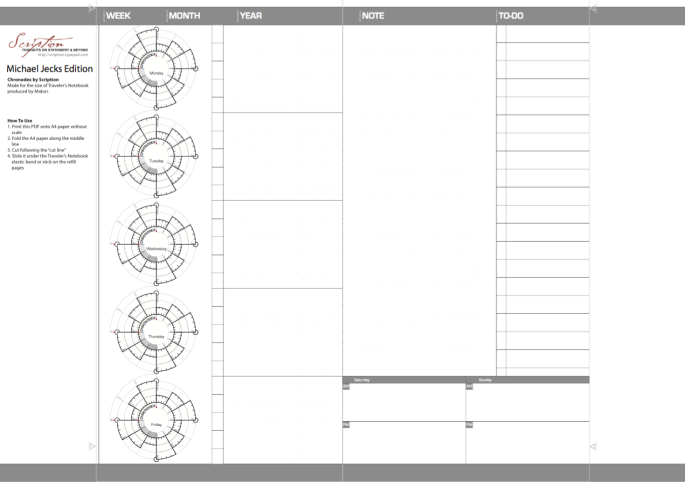Chronodex

There are some tools which make sense to individuals but don’t for other people. I personally love my Apple computers (when they work) and my Nikon DSLR. I adore fountain pens and ink, and I love my Midori – oh, and my strange diary.
Years ago when I was a salesman, I used to have a diary. There was no such thing as a laptop computer when I started, only paper. I tried all kinds of diary. Yes, I did try the File-o-Fax, and found it hideously repetitive. I could not copy with planning a month in advance, then migrating events to weekly planners, then to day planners. I reckoned that the system looked lovely, and was crap in real life. To use it effectively I’d lose hours every day! Instead, I began to use other diary systems. The best, I always found was the Quo Vadis diary. This came in all sizes, but I found the A5 version suited me best. It had handy ideas, like a tear-off corner so you could flip to the right week, it had blocks for priorities and planning, but always weekly based, so your To Do list never looked too unachievable. And most of all, there was no need to repetitively copy things from one page to a daily page, or … well, I hate writing the same thing out. Let’s leave it at that.
However, as an author I’ve never needed much in the way of diaries and planners. I have certain dates which matter – publication dates, deadline dates, dates on which I am giving a talk or lecture – but most of my days stay empty because all I’m going to do is sit down and write. Who needs a diary for that?
When I started working for the Royal Literary Fund, that changed. Suddenly I had meetings booked for two days in which I would have a different student every hour or half hour. I had to remind myself what their discipline was, what year they were, and all kinds of other information. It was not easy, and I didn’t find that a sequential, line by line diary worked for me. There was not enough space in those restrictive little lines, and I couldn’t work on that basis. I tried various systems – and then I heard of Patrick Ng and his fabulous Chronodex system.
Patrick is a senior buyer for a chain of stores in Hong Kong, Taiwan and Shanghai. In 2010 he invented a new diary for himself, which he later named the Chronodex system and put out on the internet in 2012. He was like me, and had tried all kinds of different diary, and because he was the stationery buyer, he would review and test some 500 different formats: grid systems, blocks, all sorts. But like me, he just couldn’t get on with them. Unlike me, he was bright enough to analyse what he found so difficult with the existing systems, and decided that because he was a very visual person, perhaps it was the rigid blocks that gave him a headache. I know I used to find that I would write a meeting in for a morning, and when I looked at that page later, it looked as though I’d just wasted a load of time. There’s something about a rectangular gap that just looks wrong to me.
In place of blocks, Patrick designed a system based on clocks. His Chronodex pages are indicators of time. They represent a day based on a clock face, with 6-9.00 am in the very centre, 9-21.00 in the main ring, and 21-24.00 at the outer edge. The ring has the same layout as a standard clock face, and meetings can be blocked off easily by hatching or colouring each of the sections – 11-12.00, or 13.15-14.30 – with all the space around the clock face left free for notes and more detailed comments. This means that the page has a lot more space for notes while keeping the analogue clock face so I can see at a glance when I have free time. I know Patrick uses his with colour coding so he can see what is business, what is time for his family and so on, but for me that’s taking things too far. I only ever carry one pen or pencil with me!
Not only does he have the basic format set up, he’s also created daily planners for those who have lots of meetings in a day. As I said, I don’t have to worry about that much, but every so often I have meetings in London when there are book launches and events, and I do need to organise my day more efficiently. On those days I use the “Getting Things Done” planner.
Well, a few weeks ago, Patrick asked me how I was getting on with things, and I mentioned a couple of things I was thinking of with the Chronodex. He was brilliant, and said he’d incorporate them. And now, I have a new Chronodex system designed especially for me!
This is not something that will work for everyone, any more than the Quo Vadis or the File-o-Fax would, but I can recommend it for those who are more visual; the sort of people who, like me, much prefer an analogue watch to a digital, or those more used to playing with a free-format mind map rather than a list.
Patrick is working now with a major stationery house to market and sell the scheme more widely. All I can say is, I wish him all the best of luck. It’s been a life-saver for me, and I’m sure it would help a lot of other people too.
I should apologise to him, though. He liked my comments on the Visconti Homo Sapiens so much, reader, he bought one!





I downloaded one of his chronograph diaries but couldn’t figure out how to put the pages in the right order, got in a right pickle! Too dim 😊
LikeLike
Really? Usually there are two types of Chronodex: one has to be printed in a specific manner, and he gives instructions on the left, and the second type he has no instructions because it’s designed for automatic double-sided printers. Hmm! Sorry to hear you had a problem.
LikeLiked by 1 person
Yes I don’t have a double sided printer, so tried to follow the instructions, which is where I went wrong! Not to worry. I like how he’s done your version.
LikeLike
Hi, Fraggle, there’s a link now to a page where you can have an undated page. It means you don’t have to worry about the dates working etc, because you add the dates as you go. Hope that helps!
LikeLiked by 1 person
Cheers will ha e a look.
LikeLike
Hi!!! I love this version of chronodex. Can i download it anywhere?
LikeLike
I have had to check with the designer, and he has given his permission, so tomorrow I will upload a copy of my personal Chronodex. Hope you like it!
LikeLiked by 1 person
There is a new post today with a link to the relevant page for you to download. Hope you enjoy playing with it!
LikeLike
Looks like yours is bound properly rather than just printed out at home, where can I get one/how did you do it?
LikeLike
Hi, Sam, and thanks for the comment. No, it wasn’t/isn’t bound. I just printed it, folded it and cut it on my little guillotine, and shoved it under the elastic band. One day I might buy a set of leather worker’s markers and stitch it neatly, but I’m in no hurry.
LikeLike